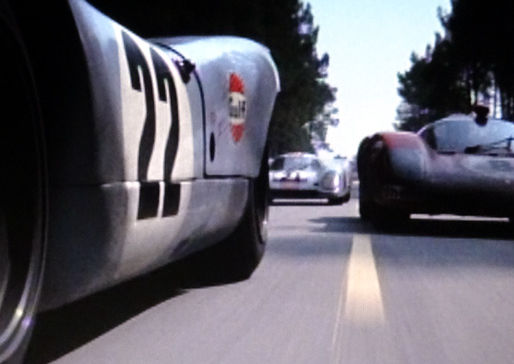top of page
Search
Drama
Classic Drama Films from 1930 - 1999


In a Lonely Place (1950)
Nicholas Ray’s In a Lonely Place (1950) is a haunting and deeply introspective noir that transcends the conventions of the genre. Though it contains many of the hallmarks of classic film noir—moody lighting, a fatalistic tone, a mysterious murder—it is ultimately less a whodunit and more a searing portrait of psychological disintegration, toxic masculinity, and the tragic chasm between love and trust.

Soames Inscker
5 min read


Dead Calm (1989)
Phillip Noyce’s Dead Calm is a taut, minimalist psychological thriller that wrings maximum tension from a deceptively simple setup. Set almost entirely on the open sea, the film traps its trio of characters—each battling their own past traumas and inner demons—within the isolating confines of a sailboat in the middle of nowhere.

Soames Inscker
5 min read


The Parallax View (1974)
Alan J. Pakula’s The Parallax View (1974) is a chilling masterpiece of American paranoia cinema—a film that captures the dread, disillusionment, and institutional mistrust that defined the post-Watergate, post-JFK era. Sandwiched between Klute (1971) and All the President’s Men (1976), it forms the central entry in Pakula’s unofficial “paranoia trilogy,” and is perhaps the most stylistically daring and psychologically disturbing of the three.

Soames Inscker
5 min read


The American Friend (1977)
Wim Wenders’ The American Friend (1977) is a haunting and hypnotic meditation on identity, corruption, and fatal friendship, filtered through the distinctive lens of 1970s European cinema. Loosely adapted from Patricia Highsmith’s Ripley’s Game, the film represents an idiosyncratic and atmospheric take on the psychological thriller, prioritizing mood over momentum, and moral ambiguity over action.

Soames Inscker
5 min read


Night and the City (1950)
Jules Dassin’s Night and the City (1950) stands as one of the bleakest, most relentless noirs of the postwar era—a shadow-drenched tale of ambition, desperation, and doom set in a seedy, nightmarish version of London.

Soames Inscker
5 min read


Play Misty For Me (1971)
Clint Eastwood’s directorial debut, Play Misty for Me (1971), is a taut, unnerving psychological thriller that helped usher in a new era of American cinema in the 1970s—where violence, sexuality, and psychological instability were explored with a rawness previously rare in mainstream film.

Soames Inscker
5 min read


Gaslight (1944)
George Cukor’s Gaslight (1944) is a masterful psychological thriller that delicately balances melodrama, gothic suspense, and noir-like tension. Adapted from Patrick Hamilton’s 1938 play Gas Light, this MGM production is more than just a classic—it is the definitive screen version of the story and the origin of a term that would enter the lexicon as a metaphor for psychological manipulation: “gaslighting.”

Soames Inscker
5 min read


Thief (1981)
Michael Mann’s Thief (1981) is a masterful debut feature—cool, precise, emotionally complex, and utterly distinctive. Though it’s nominally a crime film about a high-end safecracker and his attempt to escape “the life,” Thief is ultimately less about heists than about identity, masculinity, and the pursuit of control in a chaotic world.

Soames Inscker
5 min read


The Long Good Friday (1980)
John Mackenzie’s The Long Good Friday (1980) is a searing, stylish, and deeply political British gangster film that not only redefined the genre in its homeland but also offered a startling mirror to the social and economic turmoil of late 1970s Britain.

Soames Inscker
5 min read


The Stranger (1946)
Orson Welles’s The Stranger (1946) is a taut and fascinating post-war noir thriller—part espionage procedural, part gothic melodrama—that deserves more recognition than it typically receives in the director’s filmography.

Soames Inscker
5 min read


Blue Velvet (1986)
David Lynch’s Blue Velvet (1986) is a film that slithers beneath the manicured lawns of small-town Americana to expose a surreal and rotting underworld of violence, desire, and psychological disturbance. Bold, bizarre, and intensely provocative, Blue Velvet marked a turning point in Lynch’s career, solidifying his voice as one of modern cinema’s most original and transgressive.

Soames Inscker
4 min read


The Tenant (1976)
Roman Polanski’s The Tenant (Le Locataire, 1976) is a slow-burning psychological horror film that crawls under your skin and lingers long after the credits roll. The third entry in what has been retrospectively dubbed Polanski’s “Apartment Trilogy” (following Repulsion [1965] and Rosemary’s Baby [1968]), The Tenant is perhaps the most subtle and unsettling of the three.

Soames Inscker
4 min read


Double Indemnity (1944)
Billy Wilder’s Double Indemnity (1944) is one of the quintessential entries in the film noir canon—a sharp, cynical, and tightly coiled crime thriller that set the standard for visual style, narrative structure, and moral ambiguity.

Soames Inscker
4 min read


Bambi (1942)
When Bambi premiered in 1942, the United States was in the early months of its involvement in World War II, and Disney’s animation studio was still recovering from labour disputes and the financial aftershocks of Fantasia and Pinocchio.

Soames Inscker
5 min read


A Boy Named Charlie Brown (1969)
In 1969, amid the cultural thunderclap of the moon landing, the Woodstock festival, and the cresting waves of social revolution, a small animated film arrived in theatres with gentle colours and sad piano chords.

Soames Inscker
5 min read


Dumbo (1941)
Of all the classic features to emerge from Walt Disney’s golden age of animation, Dumbo is perhaps the most paradoxical. It is at once the studio’s shortest feature and one of its most emotionally expansive. Born of necessity—crafted quickly and economically after the financial disappointment of Fantasia—Dumbo was never intended to be a major artistic statement.

Soames Inscker
5 min read


101 Dalmations (1961)
When One Hundred and One Dalmatians premiered in 1961, it marked a decisive departure from the lush, romantic fairy-tale aesthetic that had defined Disney’s animated features up to that point.

Soames Inscker
5 min read


Watership Down (1978)
When Watership Down was released in 1978, British audiences were offered something that animation had rarely attempted at the time: a meditative, often brutal, deeply lyrical tale about survival and freedom—told through the eyes of rabbits.

Soames Inscker
5 min read


Escape to Victory (1981)
Escape to Victory (also released simply as Victory in the U.S.) is a peculiar and oddly charming fusion of World War II prison escape drama and rousing underdog sports film.

Soames Inscker
4 min read


Le Mans (1971)
Le Mans (1971) is a film unlike many others in the racing genre. Instead of taking a conventional narrative route, it offers a meditative, immersive experience of the famous 24 Hours of Le Mans endurance race held in France.

Soames Inscker
4 min read
bottom of page


